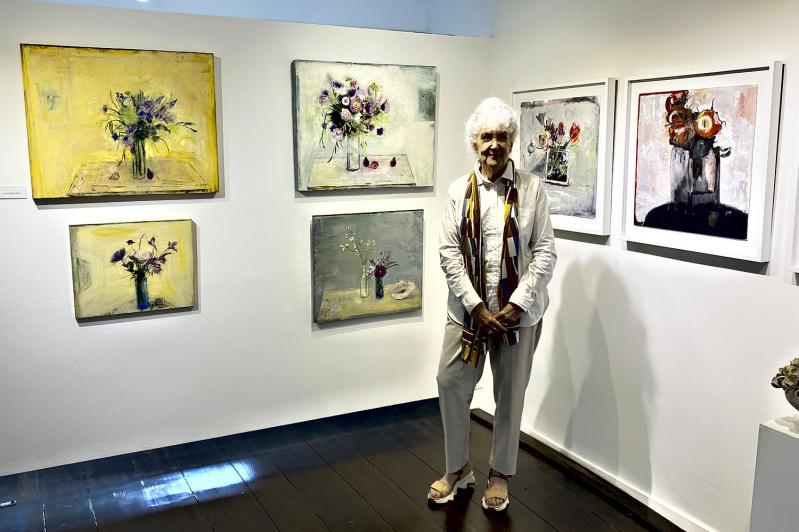In March 2023, Wendy Van Deusen announced the launch of the Women’s Arts Center of the Hamptons (WACH), whose mission was to “support and elevate women thinkers and makers through residencies, educational initiatives, community programs, exhibitions, and events for the enjoyment and enrichment of the human spirit, with accessibility for all.”
In an interview at the time with The Star, she spoke of something she didn’t yet have: a brick-and-mortar home, which she envisioned as having a gallery, a kitchen, a garden, and a library.
This year her vision became a reality.
In December she opened a pop-up exhibition, “Color Code,” at Kathryn Markel Fine Arts on Main Street in Bridgehampton. Not long after, Ms. Markel asked if she wanted to take over the lease on the space, and, after some renovation, on June 1 she opened “New Horizons: Light, Space, and Landscape” in what is now WACH’s home.
On view there through Sunday is “Summer Blooms,” an exhibition that features the artwork of Linda K. Alpern, Roisin de Buitlear, Jennifer Cross, Jane Johnson, Edwina Lucas, Barbara Macklowe, and Chala Toprak, each of whom offers a different response to the floral theme.
While Ms. Van Deusen was the curator at the LongHouse Reserve for more than 20 years, during a recent conversation she said, “It’s interesting because this is the first time I’m able to curate without a committee, so it’s a very different experience. Now it’s really just according to what I’m dreaming up.”
One thing her exhibitions have in common is the inclusion of different mediums, because, she said, “I love ceramics, I love glass, I love sculpture, and of course textiles are my true, true love.”
In addition to paintings by Ms. Alpern, Ms. Cross, Ms. Johnson, and Ms. Lucas, “Summer Blooms” includes photographs by Ms. Macklowe, glass by Ms. Buitlear, and ceramics by Ms. Toprak.
Ms. Van Deusen heard about Ms. Toprak, who recently moved from Turkey to Brooklyn, through another ceramic artist. It was Ms. Cross who recommended Ms. Alpern’s work, when she met Ms. Buitlear, who is Irish, while leading WACH’s Jewels of Ireland tour a year ago.
In fact, tours are one of several ways in which WACH differs from a traditional art gallery. Next up is a five-day trip to Asheville, N.C., where participants will visit the Black Mountain College Museum and Arts Center, the Penland School of Craft, the Asheville Art Museum, and the Biltmore Estate, where an exhibition of Dale Chihuly’s glassware is on view. Asheville’s arts and crafts scene will be explored with Sherry Masters, a craft aficionado from that city.
Ms. Van Deusen will also lead a day trip via bus next month to see the Sonya Clark show at the Museum of Arts and Design in Manhattan and have lunch at the venue’s Robert’s restaurant, which overlooks Central Park. Visits to several studios in Brooklyn will follow.
Another departure from the traditional gallery is a welcoming atmosphere. “One of the things I want to do is have afternoons or evenings when people can bring in things to work on. I do needlepoint, my basket materials are upstairs.”
She’s also receptive to artists who want to talk about or present their work. “I learned this from Jack [Lenor Larsen, LongHouse’s founder], who was the most open person when it came to other artists. He never turned down anybody who wanted him to look at their work. I want this space to be a place where people feel they can come in and hang out.”
As for the garden she envisioned, the rear courtyard is in full bloom with both flowers and plants but also bronze sculpture by Kim Boulukos and “Vertical Pearls,” a “necklace” made from cast resin and steel on a walnut base.
“Using the courtyard to have events is really nice,” Ms. Van Deusen said, adding, “I have night-blooming jasmine back there, so as soon as it blooms I’ll do a late-night thing. It really smells at night, when the sun goes down.”
Workshops are another WACH initiative, with a series of watercolor classes taught by Lois Bender now underway in the courtyard garden on Fridays through the end of August.
Ms. Van Deusen publishes a catalog for each exhibition with color photographs of the artwork and biographies of each artist. The same information remains on the WACH website, resulting in an ongoing digital archive of the venue’s exhibitions.
“I think that’s important for the artists,” she said. “Even if they don’t sell, it’s a nice thing for the artists to have, and they should be recognized.”




